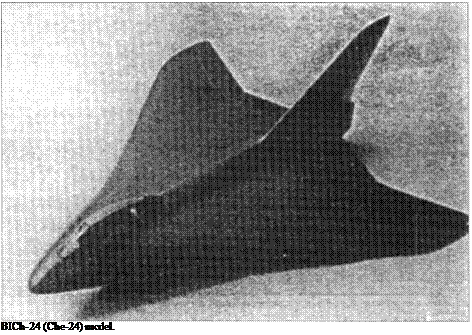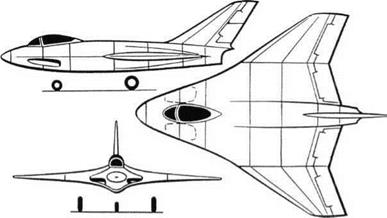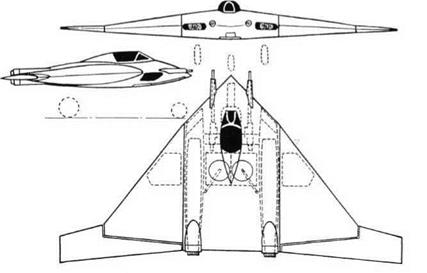BICh-24, (Che-24)
 Purpose: To investigate the tailless delta configuration.
Purpose: To investigate the tailless delta configuration.
Design Bureau: B I Cheranovskii.
With the advent of the jet age Cheranovskii recognized that he should think in terms of much lower aspect ratio. He followed his 1944 project by the graceful BICh-24 jet fighter, which he hoped to demonstrate in the Tushino ‘parade’ of 1949. To prove its flying qualities he first tunnel-tested the model depicted.
Few details have been found, but the model picture reproduced here shows the configuration. Curiously, the documents on the BICh-24 call it the Che-24. No air intake is visible on the tunnel model, and it is not known whether the 24 would have been a turbojet or rocket aircraft.
It is not known if the full-scale aircraft was built.
No data.
BICh-26, (Che-26)
Purpose: Jet fighter.
Design Bureau: B I Cheranovskii.
After the War Cheranovskii had an enhanced reputation, and he was able to build up a small team of designers to assist him with projects far more ambitious than those with which he made his name. In June 1948 the BICh-24 was followed by the BICh-25, a project for a jet fighter with variable-sweep wings with outboard pivots, uncannily like the American TFX projects of more than ten years
later. With the BICh-26 he returned to the BICh-24 formula with a fixed planform of almost delta, or gothic-delta, outline. Though Cheranovskii lived to the end of 1960 this project remained on the drawing board.
The BICh-26 was designed to have a single Mikulin (later Tumanskii) AM-5 turbojet rated at 2,000kg (4,409 Ib) thrust, fed by flush inlets in the underside of the flattened forward fuselage. The latter could equally be described as the centre section of the wing, to which the conventional outer wings were attached. On
the trailing edge were inboard elevators and outboard ailerons, and though one report states that these surfaces were fully powered they all had deeply inset hinges for aerodynamic balance. There were also upper and lower rudders, again with inset hinges. No other details have appeared.
Like its various jet predecessors, the BICh – 26 appears to have been an outstanding design with many features ahead of its time.

|
|||||||||||||||
|











